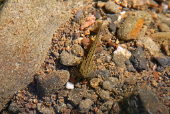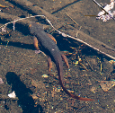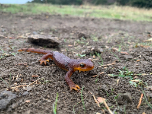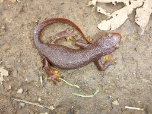California Newt (Taricha torosa)
Description: The adult California Newt is typically 4.9-7.8 inches in total length with males slightly larger than females. California Newts vary in color from a yellowish brown to a dark brown warty textured skin dorsally and a pale yellow to orange bottom on its ventral side. The aquatic larvae have a black stripe on either side of their dorsal fins and have gills in younger stages of development. They have large eyes that protrude beyond the edge of their head and light colored lower eyelids.
Habitat: The California Newt of the northern population prefers the mesic forests as opposed to the southern population newts which prefer a drier climate.
Range: The California Newt (Taricha torosa) is one of 5 members of the newt family (Salamandridae) which inhabit California. The California Newt is primarily located on the Coastal Range of California from Humbolt County to the Mexican border. Other isolated populations are also located in California, along the western slope of the Sierra Nevada mountain range.
Found in these States:
CA
Diet: The diet of an adult California Newt consists of earthworms, snails, slugs, and sowbugs. Adult newts have also been known to cannibalize their own eggs and larvae. There is little known about the diets of the California Newt during the larvae stage.
Reproduction: Mating for the California Newt takes place from December to early May. The California Newt often migrates back to breed where they developed as larvae. Courtship of the California Newt involves a dance ritual in which the male mounts the female and rubs his chin over her nose and flutters his tail. After approximately an hour the male dismounts and leaves a spermatophore, in the form of a small mound, for the female move over and retrieve with her cloaca. The female California Newt will lay their eggs in ponds, lakes, and slow moving streams in water typically not deeper than 5 inches. They lay from 7-30 eggs (approximately 1.9-2.8mm in diameter), attached to exposed roots or unattached on the bottom. The eggs are protected by a gel-like membrane that is toxic. The incubation period is usually 14-21 days and often longer depending on weather conditions. The size and amount of time in the larvae stage depends on the food sources and environmental conditions of their habitat
Status: Listed as Near Threatened because of a population decline, suspected to be 15-20% over the course of three generation lengths (15-18 years) starting in 2011 due largely to habitat loss and degradation, thus making the species close to qualifying for Vulnerable under criterion A.
»» Kingdom: Animalia - Animals
»» Phylum: Chordata - Chordates
»» Subphylum: Vertebrata - Vertebrates
»» Class: Amphibia - (Amphibians)
»» Order: Caudata - Salamanders
»» Family: Salamandridae - Newts
»» Subfamily: Pleurodelinae - Pleurodeline Newts
»» Genus: Taricha
»» Species: Taricha torosa - California Newt
This article uses material from the Wikipedia article "California Newt", which is released under the Creative Commons Attribution-Share-Alike License 3.0. Content may have been omitted from the original, but no content has been changed or extended.
|








